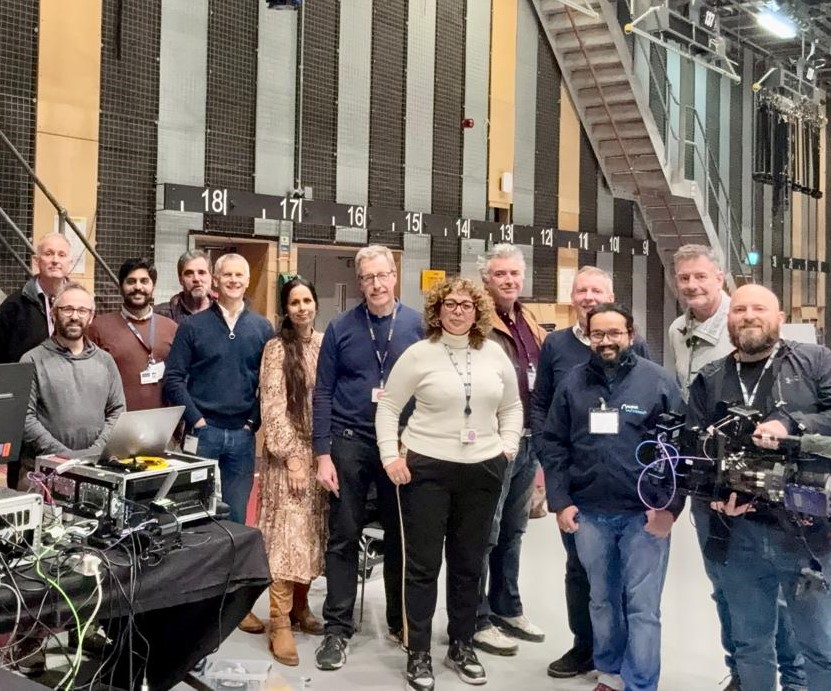01
Spectrum
02
Costs
03
Deployments
Unlocking
the power
of private 5G
ON-SIDE is a co-innovation project which puts power in the potential of 5G networks.
Our project aims to turn the vision of private 5G networks into a practical reality by driving innovation and proving viability, benefits, and value in real-world settings.
We’ll achieve this by stripping back the barriers to innovation: pioneering nimble routes to spectrum sharing, and shaving back deployment costs.
We’re testing what works, where — and showing how to get there.This will involve building and deploying standalone, pop-up 5G networks across Glasgow and the north of England, connecting everything from ports to sports, universities and care homes. We’ll use private networks for live broadcasts, transport operations, cutting-edge teaching technologies, and new cultural experiences.
Stripping back the barriers to innovation
ON-SIDE’s deployments will include rigorous, best-in-class demonstrations which will provide the real-world data we need to evaluate their viability and benefits, guide future policy, and pave the way for other places and organisations across the UK to run their own private 5G standalone networks.
Our team’s appetite for collaboration is matched by our wealth of shared expertise. ON-SIDE brings together big tech leaders, academic trailblazers, local government heads, and innovators operating at the bleeding edge of their fields.
The ON-SIDE project is supported by the UK government, and will run until the end of March 2025.
Follow us on LinkedIn to stay updated.
Solving the spectrum allocation challenge
One of the key challenges in establishing private, standalone 5G networks is obtaining suitable spectrum licences.
The Shared Access licensing framework developed by Ofcom has proven a significant step forward in improving access to 5G spectrum — and established the UK as a leader in this field. We are ready now to build on these breakthroughs.
ON-SIDE is exploring ways to automate, adapt, and optimise the current system for more agile spectrum allocation, in order to deliver even better spectrum utilisation and further broaden access — enabling new use cases for private networks that aren’t feasible within today’s framework.
Breaking down the cost barrier
Private 5G networks today can be cost-prohibitive for certain uses and scenarios. As new network configurations are developed, supply chains continue to diversify, and private networks proliferate, this cost barrier will become lower. ON-SIDE wants to accelerate this process. We’re designing new configurations that will support a wider field of equipment manufacturers, and we’re testing the viability of adapting enterprise-grade network cores to smaller-scale private deployments in both fixed and portable setups.
Our progress and our discoveries will also be used to shape and inform future 5G business cases that are able to manage or mitigate the costs associated with running private standalone networks.
How we show our working
In order to demonstrate — and evaluate — our innovations, we’re building and running standalone, pop-up 5G networks across Glasgow and the north of England. Our test sites will connect everything from ports to sports, universities and care homes.
Our deployments are designed to provide clear, honest assessments of what works when it comes to standalone 5G networks. We’ll be evaluating how well our spectrum allocation and cost reductions work when applied to real-world scenarios. That means being frank about those cases in which a private network isn’t the best solution — and opening up our findings to suggest alternatives.
Deployments
All the angles at your local stadium

Few experiences rival the energy of watching your football team play at their home stadium.
Our standalone 5G network will offer the ability to bottle and distribute the energy from the stands in novel, exciting ways, with fans able to transmit their perspectives directly from their mobile handsets to broadcast producers beaming the game out to homes, pubs, and football clubs around the world — all in real time.
Our learnings can also apply to other popular and growing sports in Scotland, such as cycling, golf, and basketball.
“You join us live from…”

…pretty much anywhere you can imagine.”
Private 5G networks that can be sprung up to support non-studio broadcasting offer the flexibility, cost-effectiveness, and sturdy connectivity that reliable broadcast output requires. We aim to prove that.
The potential of 5G won’t be limited to the field, however. We’re also exploring how a standalone 5G network in a TV studio can provide the opportunity to run multiple services from a single piece of radio infrastructure, smoothing the production process and bringing down technical costs at the same time.
From the airwaves to the airport

Modern airports are a hive of activity, where safety, strict timetabling, and security are paramount. All of this is underpinned by a complex network of communications.
That’s why we’re working with airports to see how a private 5G network could help an airport’s operations, from runway checks to wildlife logging, resourcing, CCTV monitoring, and airside incident tracking.
Connecting ship and shore

Ports often have ship-to-shore connectivity and communication problems; we’re going to deploy a 5G Private network at one to see how we can solve it. Possible use cases include automation and remote control of cranes, monitoring of vessels, enhanced CCTV, and ubiquitous mobile connectivity across the port — meaning that port staff will no longer be ‘all at sea.’
Teaching the next generation with next-gen tech

A private, sandbox 5G network will be used to power next-generation teaching technologies at the University of Glasgow.
The university’s ‘clean rooms’ — critical for research in fields like nanotechnology, biotechnology, and semiconductor manufacturing, as well as live operating theatres — will be fitted with 360-degree cameras to capture and livestream classes and procedures in real time, bridging the gap between theoretical knowledge and practical skills. Research students will be able to navigate spaces virtually and aspiring medics will be able to follow live surgical procedures via VR headsets, massively expanding access to learning experiences typically limited by space and safety concerns.
Meet the experts
The ON-SIDE consortium is built on a foundation of collaboration. It brings together partners from across industry, academia, and local government, all offering a wealth of expertise and experience.
Cisco is the worldwide leader in IT and networking, and helps companies of all sizes transform how people connect, communicate, and collaborate.
https://www.cisco.com/
The University of Strathclyde is a leading international technological university based in the centre of Glasgow. Our Software Defined Radio lab is engaged in research and development covering a range of topics which include agile radio networks, spectrum sharing and innovative spectrum management, Open RAN, neutral hosting, and bespoke private 5G networks. We collaborate with industry and government to ensure that innovation and knowledge exchange are fundamental activities that deliver tangible impact in the field of wireless connectivity.
https://sdr.eee.strath.ac.uk/
The University of Glasgow is a world top 100 university (THE, QS) and a member of the prestigious Russell Group of leading UK research universities. Named Scottish University of the Year by the Times & Sunday Times Good University Guide 2024, the University has been home to world-changing research and teaching for more than 570 years. As a world-leading, research-intensive university, the University of Glasgow is committed to contributing towards the UN’s 17 Sustainable Development Goals and has committed to carbon neutrality by 2030. It was the first European university to declare it would divest from fossil fuels by 2024 and the first in Scotland to declare a climate emergency. In 2021, the University of Glasgow received a Queen’s Anniversary Prize for its national service to the Covid-19 pandemic.
https://www.gla.ac.uk/
Glasgow City Council is the local government authority for the City of Glasgow in Scotland.
https://www.glasgow.gov.uk/
Neutral Wireless is a modern and multi-faceted mobile communications company with extensive experience in FPGA development and Software-Defined Radio. The team have worked together for over a decade, and have a proven track-record of advising international companies and delivering projects across the globe. Neutral Wireless offers design and integration services for various potential use cases. Our “truly-mobile” Lomond Network-In-a-Box can provide a fully operational non-public network in as little as 5 minutes of set-up, and our team of specialised FPGA engineers operate across a myriad of design areas involving AMD-Xilinx hardware and SDR systems.
https://www.neutralwireless.com/
Scottish Wireless, is a strategic telecommunications advisory, combining connectivity, advanced technology, and digital intelligence expertise, has a focus on improving existing classical communications channels by the delivery of multi-sector connectivity solutions and advanced technology roadmaps integrating quantum and AI collaborative communication solutions.
https://scottishwireless.com/
The BBC is the world’s oldest national broadcasting organisation. Its research and development arm is tasked with exploring advanced and emerging media technologies. They have been involved in user cases for the use of various RF technologies including distribution, production and communications for several years. For this project the BBC is interested in the applications of 5G private networks to support low latency, high bandwidth applications for cameras and other devices used in a studio environment.
https://www.bbc.co.uk/rd
Logicalis UK&I is a global technology service provider that delivers digital managed services. Its services across cloud, connectivity, collaboration and security are designed to optimise operations, reduce risk and empower employees.
https://www.uki.logicalis.com/
Blog
-
Immersive Event Broadcasting Powered by 5G
Discover how private 5G is reshaping media broadcasting with real-time video, remote production, and lower costs.
・

-
Implementation of a 5G SA Split 7.2 gNB using AMD RFSoC
Exploring Split 7.2 gNB for private 5G SA networks, enhancing performance, interoperability, and reducing costs.
・

-
The Principles of Open RAN Approaches
The 2023 coronation of King Charles III and Queen Camilla reached global audiences thanks to private 5G innovation by ON-SIDE partners Cisco, BBC R&D and Neutral Wireless. In this blog Mark Waddell (BBC R&D) and Douglas Allan (Neutral Wireless) explore this groundbreaking technology.
・

-
Building Blocks of Private 5G
Private 5G networks offer tailored, high-performance connectivity for mission-critical applications, from elite live broadcasts to remote operations. Discover the building blocks driving this secure, game-changing technology.
・

-
Exploring 5G at BBC Scotland
In this blog, Ian Wagdin from BBC Scotland dives into the ON-SIDE team’s recent efforts to test private 5G networks for studio broadcasting at the Pacific Quay studios in Glasgow.
・

-
A Year of Innovation and Collaboration
As 2024 draws to a close, we reflect on the milestones achieved by our ON-SIDE partners.
・

Keep social care connections up
With as many as 70% of people in social care living without a home broadband connection, the risk of vulnerable people being left behind by the digital divide remains all too real. We’re exploring how private 5G networks can offer the reliable, permanent connectivity required to deliver critical services such as internet connected virtual assistants — either as a standalone solution, or as a back-up to existing broadband channels.